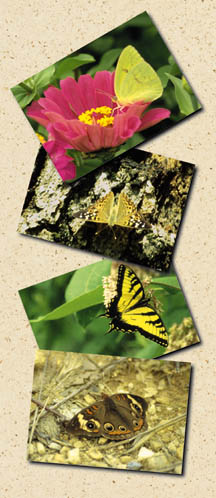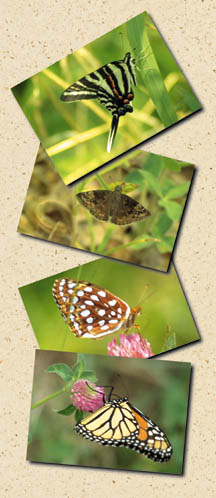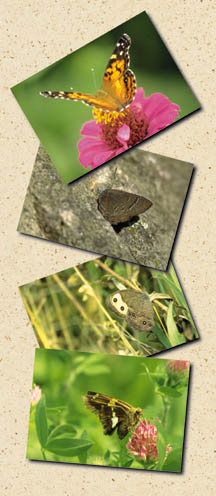


Department of Environment and Conservation
THE
TN CONSERVATIONIST
MAGAZINE
| DEVELOPMENT OF BUTTERFLYING PARALLELS BIRDING By Dr. Jerry Nagel |
 In the last decade,
butterfly watching and gardening emerged as fast growing interest areas in the
increasingly popular category of outdoor recreation known as "viewable
wildlife." Many of the participants in this pastime have come from the ranks of the
dedicated bird watchers and bird feeders since techniques and materials used in both of
the activities are similar.
In the last decade,
butterfly watching and gardening emerged as fast growing interest areas in the
increasingly popular category of outdoor recreation known as "viewable
wildlife." Many of the participants in this pastime have come from the ranks of the
dedicated bird watchers and bird feeders since techniques and materials used in both of
the activities are similar.
The histories of "birding" and "butterflying" are an interesting case of parallel development, with butterflying running about 50 years behind birding. Birding took off as a popular pastime in 1934 with the publication of Roger Tory Peterson's book, A Field Guide to the Birds. Before long, the old natural history hobby of collecting was replaced by field observation, identification, and the compiling of "life lists" of birds identified in the wild. The initial Peterson field guide to butterflies by Alexander Klots did not appear until 1951 and was mainly designed to serve the needs of butterfly collectors armed with nets, rather than watchers armed with binoculars.
During the next two decades, a number of those who initially developed an interest in butterflies through collecting became skilled enough to identify most of the butterflies in their areas without actually capturing them. In 1975, some of these naturalists participated in the inaugural Fourth of July Butterfly Count in several locations around the country. This was sponsored by the Xerces Society to promote conservation of invertebrates and was patterned on the popular Christmas Bird county sponsored by the National Audubon Society. Shortly after this, new field guides designed for the butterfly watcher began to appear and "butterflying" was underway. The term "butterflying" has been adopted as the appropriate descriptive term for this activity and parallels the term "girding" from bird watching circles.
Getting started in butterflying is easy and inexpensive. The one "must have" item is a field guide suitable for your region or the company of someone who already knows the local butterflies. The Audubon Society field Guide to North American Butterflies by Robert Pyle (Alfred A. Knopf, Inc.) contains excellent photographs but can be overwhelming to the beginner since it covers all the butterflies in North American north of Mexico. In Tennessee, it would be better to start with the Peterson Field Guide to Eastern Butterflies by Opler and Malikul (Houghton Mifflin Co.) since this reduces the number of possibilities to consider when trying to make an identification.
 In eastern Tennessee, Butterflies
Through Binoculars by Jeffery Glassberg (Oxford University Press) is an excellent
choice which reduces the number of possibilities even further. Don't be put off by the
fact that this guide is specific for the Boston-New York-Washington region; it covers 90
percent of the eastern Tennessee butterflies and would also do a pretty good job in
western Tennessee. Of the three field guides, this is by far the easiest to use.
In eastern Tennessee, Butterflies
Through Binoculars by Jeffery Glassberg (Oxford University Press) is an excellent
choice which reduces the number of possibilities even further. Don't be put off by the
fact that this guide is specific for the Boston-New York-Washington region; it covers 90
percent of the eastern Tennessee butterflies and would also do a pretty good job in
western Tennessee. Of the three field guides, this is by far the easiest to use.
The second useful item is a pair of binoculars. Unlike birding, where they are absolutely
essential, binoculars can be considered just a desirable "add on" for
butterflying. Many butterflies can be approached so closely while they are nectaring on
flowers that the appropriate equipment is the reading portion of your bifocals. Some
common butterflies that regularly fit tight for close inspection include Pipevine and
Tiger Swallowtails, Monarchs, Gray Hairstreaks, and Silver-Spotted Skippers. Other
butterflies such as the Red Admirals, Question Marks, and Wild Indigo Dusky wings are
quite wary and will commonly flush when you are still 10 feet away.
For these situations, a pair of binoculars will greatly increase your enjoyment of butterfly watching and improve your chances of getting a correct identification. A close focus capability of eight to 12 feet or closer is the most important characteristic to consider for butterflying binoculars. Light gathering ability and field of view are really secondary considerations for butterfly binoculars since the subjects are normally going to be sitting still in the sun at fairly close range.
 Even before progressing
to the point of being a capable butterflier who can identify most of the common species in
the area, you may want to take up butterfly photography. For this you need a 35mm SLR
camera that has a close-focus capability and a small electronic flash unit. Don't waste
money on an expensive close-focus macro lens; any photo supply store should be able to
outfit you with a set of screw-in diopter lenses for $15-$20. These attach to the front of
your standard lens and allow focus as close as six to 12 inches. With that equipment, load
a slow fine-grain film, set the aperture to 16 or 22, put the shutter on flash synch and
start stalking your prey.
Even before progressing
to the point of being a capable butterflier who can identify most of the common species in
the area, you may want to take up butterfly photography. For this you need a 35mm SLR
camera that has a close-focus capability and a small electronic flash unit. Don't waste
money on an expensive close-focus macro lens; any photo supply store should be able to
outfit you with a set of screw-in diopter lenses for $15-$20. These attach to the front of
your standard lens and allow focus as close as six to 12 inches. With that equipment, load
a slow fine-grain film, set the aperture to 16 or 22, put the shutter on flash synch and
start stalking your prey.
With book and binoculars in hand, it's time to decide where to go. A good place to start
is around the flower beds and flowering shrubs of the neighborhood yards. Like birds,
butterflies are highly mobile creatures and can be persuaded to linger in the yard if
provided with good nectar sources such as butterfly bush (Buddleia), zinnias, asters,
lantana, Mexican Heather and various milkweed species. Butterfly gardening is the
butterflier's equivalent of bird feeding and many people have compiled an impressive
butterfly life list without ever leaving own yards. However, some species can be found
only if you venture out. Forest habitats do not have a great variety of butterflies, but
some, such as the Carolina and Little Wood Satyrs, Pearly Eyes and Hackberry Emperors, are
typically confined to such areas. Different types of forest yield different species; the
Banded Hairstreak can only be found in dry forests consisting of pine/oak/laurel mixtures.
 The greatest diversity
of butterflies is most often found in open, disturbed habitats or grassfields. Adult
butterflies depend on flower nectar for food and flowers are most abundant in open, sunlit
areas. There you may find Great Spangled and Aphrodite Fritillaries, Common Wood Nymphs,
Clouded and Orange Sulphurs, Pearl Crescents, Common Buckeyes, and American ladies.
The greatest diversity
of butterflies is most often found in open, disturbed habitats or grassfields. Adult
butterflies depend on flower nectar for food and flowers are most abundant in open, sunlit
areas. There you may find Great Spangled and Aphrodite Fritillaries, Common Wood Nymphs,
Clouded and Orange Sulphurs, Pearl Crescents, Common Buckeyes, and American ladies.
Open, disturbed habitat can be found along country roads, power line cuts, lake and river edges, pastures and sometimes in community parks. Winged Deer Park in Johnson City is an excellent example of a community park which provides not only soccer and softball field facilities, but also a variety of trails through birding, butterflying and flowering habitats preserved for the nature lover.
When seeking butterflies, consider season, topography and host plants. Many butterflies appear only during a brief period of the year. The West Virginia White of eastern Tennessee is a forest dweller than flies only during April of each year because this is the time that its caterpillar host plants, toothworts, are available. Roan Mountain has a spectacular flight of Aphrodite Fritillaries in late July. This peak abundance occurs for about two weeks in July and then declines rapidly.
Topography can be used to uncover some exciting butterfly concentrations. In many species,
the males and females improve their chances of locating each other for mating by
congregating at the tops of hills. This "hilltopping" behavior is common among
swallowtails and anglewings.
Knowledge of their host plants can also help in locating certain species. For this, consult the field guides mentioned earlier. The state butterfly, the Zebra Swallowtail, must have Paw-paw trees to provide food for its caterpillars. If you know where there are Paw-paws, you greatly improve your chances of encountering this elegant creature.
An exciting activity which butterflies share with birders is the pursuit of "vagrants" or species well outside of their normal range. Some species, such as the American Snout of the southwestern U.S., periodically undergo massive emigrations and invade areas where they will not be able to survive the winter in any of their life stages. Coastal plan species with good mobility such as Gulf Fritillaries, cloudless Sulphurs, and Sleepy Oranges are commonly found far from their normal habitats after the passage of storms moving in from coastal areas. A Gulf Fritillary was encountered at 5,000 feet on Unaka Mountain in Unicoi County after just such a storm. An unexpected vagrant always adds a bit of excitement to the day's outing!
The growth of butterflying in the past decade has been nothing short of astounding. This rapid growth might be attributed to the publication of excellent field guides that allowed birders to begin to pursue another groups of colorful, winged creatures after the morning bird activity began to wane. Field-guide-bearing butterfliers also come from the ranks of backyard flower gardeners, may of whom now tailor their gardens to the taste of passing butterflies. In 1993, this growing interest was recognized with the founding of the North American Butterfly Association (NABA), an organization which seeks to promote interest in various aspects of butterflying such as field observation, life-listing, rearing, photography, conservation and butterfly gardening. Membership is $25 for regular members or $35 for family members and includes the magazine American butterflies and two newsletters. The address is: NABA, 4 Delaware Road, Morristown, NJ 07960. They also have a Web page on the Internet at http://www.naba.org. The NABA recently assumed responsibility for the Fourth of July Butterfly count and is working to develop more participation in this program. Membership in this groups is an enjoyable way to learn more about the joys of butterflying.
(Dr. Jerry Nagel is a professor emiritus of biological sciences at East Tennessee State University in Johnson City.)
Updated June, 1997; Send comments to Department of Environment and Conservation.